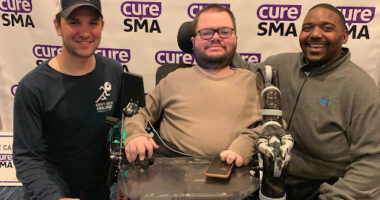The patient-provider relationship: Improving team communication
Kevin Schaefer, who lives with SMA type 2, and neurologist Edward Smith, MD, reflect on challenges in healthcare team communication, and then share strategies for overcoming these barriers.
 Find a specialist near you
Find a specialist near you
Transcript
Kevin: I am very fortunate in this regard in that I go to clinic twice a year where all my main specialists are there. So that’s where I see neurology, pulmonology, nutritionist, OT, PT. So, it’s very great for me that I can have everyone literally there in the same building communicating with each other. And that would be the ideal scenario for, really, everyone with SMA.
That’s worked out really well for me, and Dr. Smith was a big part of implementing that at Duke and it’s worked out great. But even if you don’t have a setup like that, I think doctors that you see should definitely be in contact with each other because, you know, it all plays a part in the well-being of someone with SMA to have a physical therapist and a neurologist in touch with each other and other members.
So I’m very fortunate in that regard because it’s all set up like that. But Dr. Smith, what other, what else would you say to that, especially for patients who don’t have a clinic setting like that?
Dr. Smith: Yeah, yeah, I agree with everything you said. I think it’s a challenge. So that is one of the big advantages of a multidisciplinary clinic, is that all the relevant providers are in there together and not trying to connect with each other outside of clinic through email, which just doesn’t happen very well.
So when you don’t have that multidisciplinary clinic option, it’s a huge challenge. I mean, I would see you and then generate a clinic note, and [the other provider] may or may not read it and may or may not generate questions and want to come to me or you with those questions.
But in those situations, I think that there’s an opportunity there to leverage telemedicine and possibly have a virtual multidisciplinary [visit] — not too complicated, but the primary care physician, the neuromuscular provider, and the patient family. That’s certainly doable.
So that’s maybe one way to sort of bridge that communication gap. I don’t think that just you seeing me and then assuming everything’s going to get transmitted to the primary care physician, it just doesn’t happen reliably or in a good way, in my experience. We’re inundated with clinic notes and information as providers and there’s just too much to keep up with. It’s the truth. And so I think trying to come up with another alternative to the in-person multidisciplinary clinic appointment and leverage telemedicine is one good option for that.
Recent Posts
- Diaphragm fatigue may contribute to breathing issues in SMA: Study
- Learning to still enjoy the holidays, despite being unable to eat
- Novartis exec: Itvisma approval ‘important moment’ for community
- Specialty pharmacy Orsini selected to provide SMA treatment Itvisma
- Making others happy is my favorite part of the holiday season
Related articles
-
January 8, 2024 by Susie Strachan
Speak up, be heard: Mastering the art of SMA care collaboration
-
January 8, 2024 by Mary Chapman
Dream team: Assembling your ideal SMA care squad
-
January 8, 2024 by Kevin Schaefer
Your kind of healthy: Defining wellness on your terms with SMA
-
January 8, 2024 by Susie Strachan
Your SMA success plan: Creating a personalized care strategy
-
January 8, 2024 by Susie Strachan
Stick with it: Unpacking the benefits of consistent SMA treatment
-
August 22, 2025 by Susie Strachan
SMA life expectancy by disease type
-
February 20, 2023 by Susie Strachan
Exercise and physical therapy for SMA










